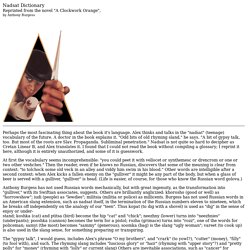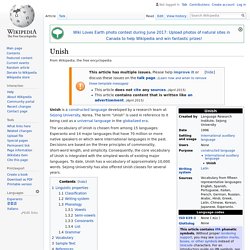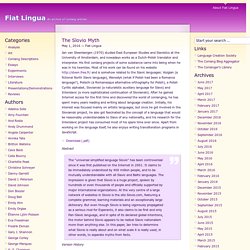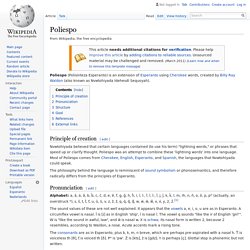

Nadsat. Nadsat DictionaryReprinted from the novel "A Clockwork Orange", by Anthony Burgess Perhaps the most fascinating thing about the book it's language.

Alex thinks and talks in the "nadsat" (teenage) vocabulary of the future. A doctor in the book explains it. "Odd bits of old rhyming sland," he says. "A bit of gypsy talk, too. At first the vocabulary seems incomprehensible: "you could peet it with vellocet or synthemesc or drencrom or one or two other veshches. " Anthony Burgess has not used Russian words mechanically, but with great ingenuity, as the transformation into "gulliver," with its Swiftian associates, suggests. The "gypsy talk", I would guess, includes Alex's phrase "O my brothers", and "crark" (to yowl?)
There are slight inconsistencies in the story when Alex forgets his word and invents another or uses our word, but on the whole he handles his Russianate vocabulary in a masterly fashion. Stanley Edgar Hyman July, 1963. Na'vi. When James Cameron’s science-fiction opus “Avatar” comes to the screen this month, audiences will witness meticulously conceived alien characters — speaking a meticulously conceived alien language.

To lend extra authenticity to the Na’vi — the tall, blue-skinned, vaguely feline humanoids living on the distant world of Pandora — Cameron enlisted the help of a linguist to construct a full-fledged language, with its own peculiar phonetics, lexicon and syntax. From the mind of Paul Frommer, a professor at the University of Southern California, was born a Na’vi language, with mellifluous vowel clusters, popping ejectives and a grammatical system elaborate enough to make a polyglot blush. Why go to all the trouble? Unish. Unish is a constructed language developed by a research team at Sejong University, Korea.

The term “Unish” is used in reference to it being cast as a universal language in the globalized era. The vocabulary of Unish is chosen from among 15 languages: Esperanto and 14 major languages that have 70 million or more native speakers or which were international languages in the past. Decisions are based on the three principles of commonality, short-word length, and simplicity. The slovio myth. Jan van Steenbergen (1970) studied East European Studies and Slavistics at the University of Amsterdam, and nowadays works as a Dutch-Polish translator and interpreter.

His first conlang projects of some substance came into being when he was in his twenties. Most of his work can be found on his website and is somehow related to the Slavic languages: Vozgian (a fictional North Slavic language), Wenedyk (what if Polish had been a Romance language?) , Poilschi (a Romanesque alternative orthography for Polish), a Polish Cyrillic alphabet, Slovianski (a naturalistic auxiliary language for Slavs) and Interslavic (a more sophisticated continuation of Slovianski).
After he gained Internet access for the first time and discovered the world of conlanging, he has spent many years reading and writing about language creation. Download (.pdf) Abstract.
Conlang generator. Elorathian. Ouranian Barbaric. Ithkuil. Definition. Poliespo. Poliespo (Polisinteza Esperanto) is an extension of Esperanto using Cherokee words, created by Billy Ray Waldon (also known as Nvwtohiyada Idehesdi Sequoyah).

Principle of creation[edit] Nvwtohiyada believed that certain languages contained (to use his term) "lightning words," or phrases that speed up or clarify thought. Poliespo was an attempt to combine these 'lightning words' into one language. Most of Poliespo comes from Cherokee, English, Esperanto, and Spanish, the languages that Nvwtohiyada could speak. A short history of the international language movement. Giyorbicon. Glaugnea2. Glaugnea.
Enochian. Klingon. Volapuk. Esperanto. Taneraic on the Web. Volapuk encoding. For the language, see Volapük.

Volapuk encoding (Russian: кодировка "волапюк", kodirovka "volapük") or latinica (латиница) is a slang term for rendering the letters of the Cyrillic script with Latin ones. Unlike Translit, in which characters are replaced to sound the same, in volapuk characters can be replaced to look or sound the same. Etymology[edit] The name Volapuk encoding comes from the constructed language Volapük, for two reasons. Cyrillic text written in this way looks strange and often funny, just as a Volapük-language text may appear. The term was popularized by its use in the first Soviet commercially available UUCP and TCP/IP network, RELCOM (a typical networking software package included Cyrillic KOI-8 to Volapuk transcoding utilities called tovol and fromvol, originally implemented by Vadim Antonov), making it the likely origin of the usage of Volapuk as applied to Cyrillic encoding.
History[edit] "MIME/BASE64, MIME/Quoted-Printable, volapuk, uuencode"[1] Rules[edit]
A tidbit of the language Orghast. In August 1971, an experimental theatre group performed a spectacle at the ruins of the palace of Darius in Persepolis.

Parts of the event were performed in Latin, Greek and Avestan, and part was done in a language called Orghast which was created by poet Ted Hughes. Here is a specimen: SÓYINNABLÁRGA I was in darkness FÓTTAHOÁNYAbrought into light GRÓKIDOTÚTTU I was broken in pieces GUÉRRAOÁNYAlight healed me. Láadan Language.